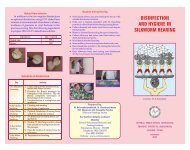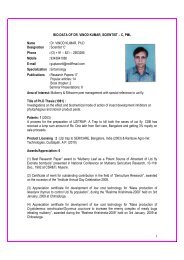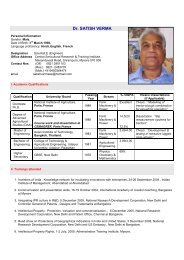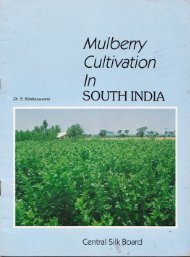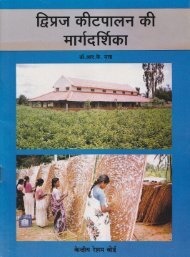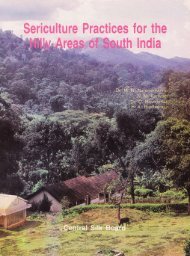re&rew&*
Manual on Young Age Silkworm Rearing - Central Sericultural ...
Manual on Young Age Silkworm Rearing - Central Sericultural ...
Create successful ePaper yourself
Turn your PDF publications into a flip-book with our unique Google optimized e-Paper software.
e&rew&* #?e<br />
Y&rere# ffiffiffituW#rffi€*rere<br />
R€&ffiffiWffi<br />
R,K, HAJAN<br />
AKIYOSHI MUROGA<br />
H,K DATTA
H<br />
I<br />
MANUAL ON<br />
YOUNG SILKWORM REARING<br />
R. K. RAJAN<br />
AKIYOSHI MUROGA<br />
R. K. DATTA<br />
JICA BIVOLTINE SERICULTURE TECHNOTOGY DEVELOPMENT PNbIECT<br />
CENTRAL SERICULTURAL RESEARCH AND-TRAINING INSTITUTE<br />
MYSORE (tNDtA)
Decembe4 1996<br />
IA00 Copies<br />
Published by :<br />
Dn R. K. DATM<br />
Director<br />
Central Sericultural Research &<br />
Tiaining Institute<br />
Manandavadi Road, Mysore-57} 008<br />
Editor :<br />
A. K. GANGULY<br />
Assisted by:<br />
B. S. PAPPU<br />
Cover Design :<br />
SYED MUNAIYAR<br />
Pice : Rs. 601-<br />
Pinted at :<br />
Raja Printers<br />
No. 59, [Vth Cross Lalbagh Road<br />
Bangalore-27, Phone : 2234066
PREFACB<br />
Japanese scientists are guiding Indian scientists of Central Sitk Board since 1991<br />
under the Japan International Co-operation Agency (JICA) aided Bivoltine Sericulture<br />
Tbchnologt Development Project @STDP) in six majorfields of seiculture, viz. Mulberry<br />
Breeding and Cultivation, Silh,vorm Breeding, Silkworm Reaing, Sillouorm Disease<br />
Control, Seed Production kcltnologt and Silk Reeling. In Silkworm Reaing two long<br />
term experts and three short term experts worked in Reaing Tbchnologt Laboratory<br />
and helped in developing reaing technologt for bivoltine seiculture. Four scientists<br />
from Reaing Tbchnolog Laboratory were also trained in Japan. This manual is the<br />
outcome of tke studies conducted in Reaing Tbchnolog and Innovation Laboratory<br />
of the CSRTI, Mysore duing the project peiod.<br />
The young sillcworm reaing is a very important aspect of seiculture industry.<br />
Successful young silkworm reaing depends upon the pe(ect understanding oJ'nutitional<br />
and environmental conditions. Failure of sillcworm crop is oJien traced to bad<br />
manogement and reaing of young sillc,vorms. This aspect is therefore more important<br />
in the case of bivoltine silkworm reaing. Although enough information ere available<br />
elsewhere on young silkwornn reaing an indepth study on the practical aspect of<br />
commercial chawki reaing in Indian conditions with a focus on the nutitional aspect<br />
has become essential. This manual provides relevant information with updated technologt<br />
of practical utility with regard to vaious chawki rearing operations.<br />
This manual will serve as a hand hook to the technical personnel dealing witlr<br />
the co-operative chawki reaing centres to achieve full potentiality of young silhuorm<br />
reaing in tropical conditions. We are grateful to Dr Y Ohtsuki, JICA Tbam Leade4<br />
for his guidance and suggestions. We are thanlrful to Dr T Inokuchi, Dr. M. Miki and<br />
Dr Kuribayashi, JICA Expefts for their valuable contibutions in bringing out this<br />
manual. We acknowledge the assistance extended by the scientists in Rearing<br />
Tbchnologt Laboratory. We are also grateful to Japan Intemational Co-operution Agency<br />
(JICA) for making this study possihle through the BSTD project.<br />
R.<br />
K. R.ajan<br />
Akiyoshi Muroga<br />
R. K. Datta
CONTENTS<br />
Introduction .................:............. ....:.............. ..............................1<br />
Page<br />
Handling of Silkrvorm Eggs .............1<br />
Rearing House for Chawki Rearing ...................2<br />
Disinfection of Rearing House ..........4<br />
Incubation of Sillnvorm Eggs ...........4<br />
Black Boxing..... ..................5<br />
Postponing of Hatching.......... ..............5<br />
Brushing of Sillavorm Larvae.<br />
Brushing Methods<br />
Brushing of Sheet Eggs<br />
Brushing of Loose Eggs<br />
Characteristics of Young Silkworms ...................7<br />
Environmental Conditions for Young Silkworms ................9<br />
Temperature<br />
Humidity<br />
Light<br />
Air Current<br />
Maintenance of Environmental Conditions<br />
Mulberta Leaves for Young Sillavorms ...........11<br />
Food value of Mulberry varieties<br />
Agronomical Practices for Chawki Rearing<br />
Selection of Mulberry leaves<br />
Preservation of Mulberry leaves<br />
Rearing Methods for Young Silkworms ...........15<br />
Box Rearing<br />
Stand Rearing<br />
Chamber Rearing<br />
Spacing 19<br />
Frequency of C1eanin9................ ........19<br />
Moulting Care......... ..........20<br />
T[ansportation of Young Silkrvorms ................20<br />
Chawki Rearing Centres and its Management.........,..... .....................21<br />
Conclusion .....22<br />
Annexure 1................ ........23<br />
Annexure 2............... .........24
INTRODUCTION<br />
The young age silkworm rearing or chawki rearing is a vital aspect of sericulture industry<br />
for the development of healthy larvae and harvesting of successful cocoon crop. After purchasing<br />
the silkworm eggs, it is better to incubate and rear young silkworms upto second moult in a<br />
chawi
Sitrkworm eggs should be transported from the grainages during the cooler hours of the<br />
day and specially designed egg transportation bags designed by CSRTI, Mysore could be used<br />
for the purpose (Fig. 1). These bags are specially designed to maintain high humidity ancl reduce<br />
the temperature by wetting the surface. The bag has got a capacity to transport 400 Dfls of<br />
sheet eggs. As far as possible eggs should be incubated in the grainage and eggs should be<br />
supplied during eye spot stage i.e., two days prior to hatching and kept in a black paper cover.<br />
Rearing House for Chawki Rearing<br />
It is desirable to have separate rearing house or room for young silkworms preferably with<br />
RCC roofing and provided with good ventilation (Fig" 2). If the rearing house is too big, it is<br />
difficult to maintain optimum temperature and humidity. Young age rearing house or room can<br />
also be used as an incubation roorn for silkworm eggs.<br />
The building structure should be such that fluctuations in external environmental conditions<br />
should not affect the inside condition and thus the inner climate can be regulated. It would be<br />
convenient for this purpose that the house is built with thick walls or double wall with air pocket<br />
inside or with hollow bricks. Providing false ceiling and ventilators also help in regulating<br />
environmental conditicns. Rearing house must be partitioned into several rooms in order to<br />
make it convenient for rearing and maintaining the temperature and humidity.<br />
Building Plan of Model Chawki Rearing House (10,000 DFIs)<br />
ELE VAT ION<br />
ltt<br />
83-9<br />
L EAF<br />
STORE<br />
ROOM 2<br />
ll<br />
?0x26<br />
ROOM 3<br />
2ot x ?6t<br />
tl-b D<br />
l*r----"r"<br />
3ll+<br />
PLAN<br />
DRG. No. CsB-SED- L -106
Fig. I - Egg transportation bag<br />
Fig. 2 - Model chawki rearing house
A model for rearing 10,000 Dfls at a time upto second moult is given and equipment<br />
required in Annex.1. A building of size of 85' x 33' is proposed. Instead of one big hall, three<br />
separate rooms are proposed for the purpose of maintaining temperature and humidity. Each<br />
room in the model can accomodate seven chawki stands with sufficient working space. 3500<br />
Dfls can be reared upto second moult in each room.<br />
Disinfection of Rearing House and Equipments<br />
Before receiving the silkworm eggs,the rearing house and rearing equipments must be<br />
cleanecl thoroughly and washe d in 5%o bleaching powder solution. Following this rearing<br />
equipments are arranged inside the rearing house, doors and windows are closed airtight and<br />
Z7o formalin is sprayed using a power sprayer. The temperature of the room should be above<br />
25"C. To disinfect 100 sq.ft. of space with equipments about 1500 ml of 2% formalin (81 ml of<br />
commercial formalin) is required. After spraying, rearing house should be closed for 24 hrs.<br />
and opened only next morning. Before incubation, the rearing room and rearing equipment<br />
must be made completely pathogen free. It is also necessary that proper hygienic conditions<br />
are maintained insicle the rearing house during incubation and rearing.<br />
Incubation of Silkworm Eggs<br />
Silkworm eggs after receiving from grainages must be surface sterilized by dipping in 2%<br />
formalin solution for about 10 minutes and dried in shade before incubation. Conditions of<br />
incubation affect the hatchability ancl viability of silkworms. Incubation of eggs aim at uniform<br />
6evelopment ancl ensure uniform hatching. The incubation temperature and humidity<br />
requirement are different for acid treated bivoltine eggs and hibernated bivoltine eggs.<br />
Incubation of silkworm eggs should be done in a room having temperature of 25"C, relative<br />
humidity SAfa , air current of 0.3m per sec. and photoperiod i6 hrs. light (15-20 lux) per day.<br />
In the incubation room it is desirable that the temperature and humidity are kept at optimum<br />
level to the best of ability especially in the later period of incubation. If the humidity in the<br />
incubation room is less it will lead to mortaiity of eggs, poor hatching and weak larvae.<br />
Incubation has a profound influence on the voltinism, larval health and on the yield and quality<br />
of cocoon crop.<br />
The following chart indicates the temperature and humidity requirement during incubation.<br />
Thble 1<br />
Acid Theated Bivoltine Egg;s<br />
Days<br />
4<br />
i0<br />
26"C<br />
1i<br />
12<br />
Humid.
Hibernated Bivoltine Eggs<br />
t2<br />
24"C<br />
26'C<br />
Temp.<br />
807o<br />
Humid.<br />
75 7a<br />
During incubation, eggs should be spread in a single layer to provide uniform humidity<br />
and temperature. Eggs incubated as above hatch in 10 -11 days after incubation has started.<br />
Two days before hatching, the colour of the eggs changes into a lighter shade with a blue point.<br />
This is the head pigmentation stage. The next day the egg colour changes into blue and is called<br />
as the body pigmentation stage. These two stages are very sensitive to low humidity.<br />
Black Boxing<br />
If the eggs in the body pigmentation stage are transferred to dark room, the hatching of<br />
the eggs can be inhibited to certain extent and the growth of embryo which are late can be<br />
accelerated. This process is called black boxing of eggs. The uniform hatching of all the eggs<br />
can be made possible only when these eggs are exposed to light after black boxing. Black boxing<br />
is done by covering the silkworm eggs in black paper or black cloth. To avoid the escape of<br />
newly hatched larvae from the egg sheet, the eggs must be wrapped in a tissue paper during<br />
the body pigmentation stage. Farmers should be given a black bag containing pigmented eggs<br />
from the grainages instead of distributing eggs in early stages.<br />
Postponing of Hatching<br />
If hatching of incubated eggs has to be postponed, the following measures are to be taken.<br />
1. One day after incubation - eggs are to be kept at 5'C for postponing hatching for a period of<br />
10 days.<br />
2. More than two days passed after incubation started - incubation should be continued till the<br />
body pigmentation stage and afterwards they can be preserved at 5"C for a period of 3 days<br />
without any damage to the physiology of embryo.<br />
Brushing of Silkworm Larvae<br />
The process of transferring of newly hatched larvae (Fig. a) from egg sheet to rearing<br />
seat is called brushing. For this either a soft camel brush or feather is employed. On the<br />
expected day of hatching the eggs are exposed to light at 8.00 a.m. Good hatching can tre<br />
obtained by 10.00 a.m. This is the icleal time for brushing. Delayed brushing should be avoided.<br />
If hatching is irregular, take two days brushing separately in time. Newly hatched larvae can<br />
also be refrigerated at 10'C and 80o/c humidity and uniform brushing can be taken up.
Fig. 3 - Loose Egg Boxes<br />
Fig. 4 - Loose Eggs Incubation Box
Brushing Methods<br />
eggs.<br />
Brushing method depend on the type of egg production meth
ttig. 5 - Newly hatched larvae a{ter exposure to light<br />
Fig. 7 - First feeding for newly hatched larvae<br />
Fig. 6 - Newly hatched larvae<br />
Fig.8 - a) lst instar larvae<br />
b) 2nd instar larvae
in body weight and 300 times in body size, during this period. Thus maintenance of the quality<br />
of nutrient leaf supply from the brushing till the end of third stage becomes very crucial to crop<br />
success.<br />
In newly born larvae, the body water content remains very low, but it increases rapidly<br />
till the second instar. It requires high water content in mulberry leaves (75-80%) at this initial<br />
stage. At the early instar, ingestion of mulberry leaves is slow but digestion is high), But with<br />
increase in growth ingestibility increases and digestibility decreases. The amount of ingesta and<br />
digesta p-er given time increases in accordance with rise in temperature. The digestibility is<br />
however, not so affected by environmental temperature; but within optimum range of<br />
temperature it increases a little with rise of temperature. The amount of ingesta and digesta is<br />
higher in the case of healthy larvae than unhealthy ones and bigger in case of soft leaves than<br />
coarse leaves. Growth rate of the first instar larvae is very fast and if nutrition is poor the larval<br />
growth gets retarded.<br />
,<br />
Environmental Conditions for Young Silkworms<br />
Environmental factors such as temperature, humidity, light and air current during rearing<br />
have a remarkable influence on the growth of the larvae and ultimately on cocoon crop quality.<br />
However these influences are not same throughout the rearing period, but varies in different<br />
stages of growth. Hence. it is necessary to provide most favourable climatic conditions suited<br />
to the silkworms at diff rent stages.<br />
1. Temperature<br />
Rearing temperature can be divided into three groups in view of its effect on the physiology<br />
of silkworms.<br />
(a) 20-28'C - temperature which is harmless to the growth of silkworms. Temperature<br />
higher or lower than the range is harmful to the physiology of silkworms and cause unheaithy<br />
growth of silkworms.<br />
(b) 25'C - temperature which is favourable for the healthy growth of late age silkworms.<br />
(c) 26 - 28"C - Temperature which is favourable for making good quality cocoon. 28"C for<br />
first instar, 27'C for second instar and 26"C for third instar. If silkworms are reared in such<br />
temperature it is absolutely necessary to feed them with rich nutritive leaves in sufficient quantity.<br />
If the leaf quality and quantity are insufficient, it is necessary to lower the temperature by one<br />
degree in each instar.<br />
Regarding rearing temperature of each instar, it is better that the temperature in the former<br />
period is higher than that in the latter period. In case sufficient amount of nutritive mulberry<br />
ieaves are not given to silkworm, high temperature will be harmful to the physiology of silkworm<br />
injuring the health and produce poor quality cocoons.<br />
2. Humidity<br />
The effect of rear:ing humidity upon the growth and health of silkworm is similar to that<br />
of rearing temperature. High humidity makes the length of the growing period of silkworms
short, accelerating the physiological activities whereas low humidity makes the length of the<br />
growing period longer. Humidity influences the physiological functions of silkworms directly.<br />
The amount of ingestion, digestion and metabolism increase with rise in humidity. Indirectly<br />
humidity affects the rate of drying of mulberry leaves in the rearing bed thereby its suitability<br />
as a feed and its consumption. Low humidity causes drying of mulberry leaves, recluces<br />
consumption, retarded larval growth and larvae become weak and easily susceptible to diseases.<br />
Cnnsiclering the overall effect humidity range of 85% - 90% in first and second instar and 807o<br />
in third instar are ideal for young silkworm. But if the air of the rearing room is too moist it<br />
becomes favourable for the growth of pathogenic microbes and consequently silkworm suffer<br />
from diseases. During moulting period, low humidity of about 70o/o is preferable for the drying<br />
of the rearing bed.<br />
'3. Light<br />
Silkworms are fond of dim light of 15-30 lux and avoid strong light and darkness. Light<br />
has little influence on the health and survivability of silkworms, but it influences the distribution<br />
of larvae in rearing bed. Longer photoperiod during early instars strongly affect the hibernating<br />
character in the next generation, silkworms require a minimum period of 16 hrs. light per day.<br />
ln case of silkworms reared in such conditions the weight of cocoons and cocoon shell become<br />
heavier than that of the larvae reared in dark condition. It is also necessary that light is provided<br />
from upper surface of rearing bed while keeping the under surface dark, otherwise late growing<br />
of larvae and missing number of larvae increases.<br />
4. Air Current<br />
oxygen through tracheae which are distributed throughout the body. Fresh air is required for<br />
silkwofms. In the rearing room the air is polluted with COz from workers and mulberry leaves,<br />
fclrmalclehyde gas from disinfectants and ammonia from litter . The safe limit for silkworm<br />
rearing is COz 7-27o, formalin gas 7Vo, SOz 0.02o/a and ammonia 0.1 Va. The young silkworms<br />
are less resistant to toxic gases. Since the production of these gases are comparatively less during<br />
.early instars, it is less important to ventilate during younger stages than during later instars.<br />
However, care should be taken to remove paraffin paper cover and keep rearing bed open<br />
before each feeding to allow the movement of fresh air. It should be remembered that high<br />
moisture in the bed helps harbouring of fungus and other pathogens.<br />
Maintenance of Environmental Conditions<br />
The optimum temperature and humidity required for young silkworm rearing is26-28C<br />
and 85-90Vo relative humidity. If the room temperature is below the optimum level, rearing<br />
room should be heated up by electric heater or charcoal stove especially during night time in<br />
winter season. By proper designing of the rearing house, by providing circulation of air, rearing<br />
room can be protected from the effects of high temperature outside.<br />
Regulation of humidity for young age rearing is achieved by performing box rearing or<br />
paraffin paper rearing and providing folded wet news paper around the rearing bed. However,<br />
10
use of wet foam pads are not advisable for increasing the bed humidity as they could be major<br />
source of contamination. The paraffin paper which is used as a seat and cover can be folded<br />
on all the four sides (wrap up rearing) to prevent the driage of mulberry leaves if temperature<br />
and humidity are maintained inside the rearing room. Rearing humidity above 90o/a is not<br />
desirable for young age rearing and during such period box rearing method and use of paraffin<br />
paper cover can be dispensed with.<br />
Temperature<br />
Humidity<br />
Table2<br />
Requirement of Temperature and Humidity During Early Instars<br />
I instar II instar III instar<br />
28"C<br />
85-907o<br />
Mulberra Leaves for Young Age Silkworms<br />
27"C<br />
85%<br />
26"C<br />
Mulberry leaves are the sole food for silkworms in comrnercial sericulture and the quality<br />
and quantity of the mulberry leaf fed during rearing decide the success of silkworm crop. Hence<br />
choice of muiberry leaves suitable for healthy growth of silkworm is one of the most important<br />
factor in sericu'lture. Mulberry leaves suitable as food for silkworms must contain several<br />
chemical constituents such as water (.80Vo), protein (27%), carbohydrate (1IVa), mrnerals and<br />
vitamins and these must have favourable physical features such as suitable tenderness, thickness,<br />
tightness etc., in order to be eaten by silkworms.<br />
SOqo<br />
('<br />
-. {<br />
Fig. 9 - Soft leaves for infant silkworms - rich in water content, protein, carbohydrate and minerals"<br />
11
The leaves for infant silkworms must be soft and rich in water conterlt, protein, carbohydrate<br />
and minerals (Fig. 9).To attain high level of moisture in the leaf, mulberry garden should be<br />
provided with high quality of FYM (40 tonnes) and the garden should be irrigated every 5 days<br />
from the day of pruning. Alternatively, drip irrigation or sprinkler irrigation can be arranged<br />
every day.<br />
Agronomical Practices for Chawki Mulberry Garden<br />
Since young silkworms require specific quality leaves and such leaves are not produced<br />
from a general garden, specific packages have been developed for producing mulberry leaves<br />
of required quality for young age silkworm rearing.<br />
The mulberry plantations should be taken up in a flat land with porous fertile sandy<br />
loamy soil. For new chawki garden V1 or 536 variety is preferred and spacing of 60 x 60 cm is<br />
ideal. After an establishment period of one year, the plants should be pruned at crown, 20 crn<br />
above ground level during onset of monsoon. After 35 days of bottorn pruning harvesting of<br />
leaves is commenced for next 10 days (up to second moult). At the end of rearing the top<br />
terminal bud is to be clipped. Twenty five days after top clipping second harvesting of shootlets<br />
is to be done for rearing worms up to second moult. Thereafter plants are again pruned at<br />
crown (80th day after first pruning). This rycle has to be repeated four times to get 8 crops in<br />
a year.<br />
The annual dose of manuring is 40 mt FYM per ha applied in two equal splits in first and<br />
fifth crop. The annual fertilizer dose worked out is 225 N:150 P:150 K Kg per ha. It is to be<br />
applied in 8 equal split doses at 28 N:19 P:19 K Kg per ha per crop. This can be applied as 127<br />
Kg Suphala 15:15:15 + 20 Kg of Urea per crop.<br />
3.75 ha cm of irrigation water is to be provided once in 4 - 6 days by ridges and furrow<br />
method (85000 gallons of water per ha each time). Individuai leaf picking is recommended for<br />
first, third, fifth and seventh crop, while shootlet are to be harvested. in second, fourth, sixth<br />
and eighth crop for the purpose of rearing. Piants can be pruned at the crown, 20 cm above<br />
ground level four times in a year after second, foilrth, sixth and eighth crop matching with the<br />
training schedule. The above technology ensures a high yield of 28 mt of chawki leaves per ha<br />
as against 7 mt per ha in ordinary garden. The economics of maintaining chawki mulberry<br />
garden is given in Annexure 2.<br />
Food Value of Mulberry Varieties for Young Age Silkrvorm Rearing<br />
Thirteen mulberry varieties in CSKtr'I germplasm were analysed for their food value for<br />
young age rearing by moulting test and larval growth after first moult. Silkworms were fed with<br />
just sufficient quantity to initiate and complete moulting. The first instar larvae is more ideal<br />
for mouiting test since in the first instar 607o of the eating period represents active ingestion<br />
and digestion. In all other instars the moulting ratio is also dependent on the robustness and<br />
growth of trarvae in the previous instar. The newly hatched larvae are more homogenous in all<br />
aspects than in other instars. Since the larval period and growth are linked to rearing<br />
temperature and hurnidity, moulting test was done under controlied conditions of temperature<br />
12
Fig. 10 - Feeding of rich nutritive leaves in sufficient quantity is absolutely<br />
necessary in young age silkworm rearing.<br />
Fig. f 1 - Arranging of leaves for chopping manually.<br />
Fig. 12 - Chopping leaves by leaf chopping machine.<br />
13
and humidity. The study indicated that Vl variety is best suited for young age silkworm rearing<br />
followed by 536, V4, S54 and S34 (Fig. 10). A study on the conversion efficiency of mulberry<br />
leaf to cocoon shell also indicated that V1 mulberry variety is superior to all the other mulberry<br />
varieties and is at par with superior Japanese rnulberry varjety lchinose.<br />
Selection of Mulberry l-eaves for Young Age Silkrvorms<br />
Mulberry leaves for young silkworms must be soft and rich in water content (78-80Vo),<br />
prgtien (26-2S%) and carbohydrate (IlVo). The top tender leaves meet these requirements. In<br />
individual leaf feeding the largest glossy ieaf and 4 to 5 leaves below it contain high moisture<br />
and protein%o are preferred. In case of shootlet feeding, the small lateral branches with 5 to 6<br />
leaves are preferred.<br />
Silkworms do not feed well on leaves pithered more than l0%0. The consumption by the<br />
worms changes in accordance with the moisture content in the leaves. Therefore, it is important<br />
to suppiy fresh treaves and arrest quick withering of leaves both While in storage and in the<br />
rearing bed. {Jnder tropical conditions leaf driage is faster. Leaves plucked in the morning are<br />
better than those in the evening. When large quantity of leaves are required the harvested<br />
leaves should be transported immediately to the rearing house in baskets covered with polythene<br />
sheet or wet cloth.<br />
Pneservation of Mulberry Leaves<br />
Harvested leaveslshootlets must be preserved in a clean germ free area under high humidity<br />
and low temperature. For preservation of small quantity of leaves earthern pot buried in wet<br />
sand is ideal and also cheaper. For large quantity of leaves, wooden chamber covered with<br />
gunny cloth and polythene sheet can be used.<br />
The length of the period for preservation of leaves rnust be limited ta 12 hrs and leaves<br />
should be periodically turned to avoid fermentation and decaying of the quality. In summer<br />
sprinkling of water on the leaves and frequent wetting of the gunny cloth covering are required.<br />
Free movement of air heips to preseve the quality of leaves.<br />
Feeding for Young Silkworms<br />
fo{ulberry leaves for young sillcvorm aie to be harvested in the cool hours of the day and<br />
should be preserued in cool and wet condition to prevent them from withering . Leaves should<br />
be chopped in order that they are supplied to silkworms evenly. The size of the chopped leaves<br />
are variab,le aceording to the form of leaves and larval stage'(Fig. 11)<br />
Thble 3<br />
Size of Feeding Leaf in Early Instars<br />
lnstar<br />
Ist instar<br />
IInd instar<br />
trIIrd instar<br />
Chopped leaves<br />
(mro2)<br />
6-12<br />
12-18<br />
18-30<br />
Shootlets<br />
(mm2)<br />
t2-24<br />
13-24<br />
entire<br />
14
Size of the chopped leaves should be smaller in the earlier stage premoulting stage of each<br />
instar and larger at the voracious age of each instar (Fig. 12)" The amount of rnulberry leaves to<br />
be supplied to silkworms, the frequency of feeding etc. are variable accordingly to the rearing<br />
temperature, humidity, ventilation, spacing and form of leaves etc. In normal type of spacing at<br />
optimum temperature and humidity the amount of mulberry leaves supplied to silkworms and<br />
frequency of feeding for 10,000 larvae are as given in Thble 4.<br />
Rearing Methods for Young Age Silkrvorms<br />
There are different rnethods of young age silkworm rearing which are in practice. All the<br />
methods aims atpreventing driage of mulberryleaves fed to the silkworrns and to maintainproper<br />
temperature and humidity in the rearing bed. The most popular methods of young age rearing<br />
are box rearing, stand rearing and chamber rearing. In all the cases paraffin paper is used as both<br />
Thble 4<br />
Standard Rearing Schedule for Young Age Siltrnuorms (10.000 Larvae /25 dfls)<br />
lnstar Temp- Hr.rmidity Day Feeding Leaf Daily Instar<br />
erature , Time. Total Total<br />
(e) (e) (e)<br />
1 10.00 50<br />
14.00 70<br />
21.00 80 zaCI<br />
28'C 90%o 2 06.00 100<br />
14.00 150<br />
21.00 200 450<br />
3 06.00 100<br />
14.00 100<br />
21.00 150 350 1000<br />
4 Moulting<br />
5 09.00 200<br />
14.00 300<br />
il 27"c 8570 6 3l:33 :33 1000<br />
14.00 500<br />
21.Afr 700 1900<br />
7 06.00 550<br />
14.00 300 850 375A<br />
I<br />
I<br />
foloulting<br />
09.00 70CI<br />
14.00 1000<br />
21.00 12A0 2900<br />
m 26"C 8A% 10 06.00 1350<br />
14.00 1500<br />
21.44 1700 4550<br />
11 05.00 1500<br />
14"00 1500<br />
2i.00 180CI 480i)<br />
t2 06.00 1500 1500 137511<br />
15
Fig. 13 - Box Rearing<br />
Fig. 14 - Stand Rearing<br />
15 - a) Outside view of Chamber Rearing<br />
b) Inside view of Chamber Rearing<br />
16
seat and cover. Wet foam pads are used all round the bed to increase the humidity. But use of<br />
foam pads without proper disinfection can lead to contamination and disease" Hence, instead<br />
of wet foam pads, use of wet folded old news paper which can be disposed of after each rearing,<br />
is more ideal when humidity is below 50%. Analternate method of rearing without using foam<br />
pads is the "Tutsumi iku" " or wrap up rearing where in all the four sides of the rearing bed are<br />
folded with a paraffin paper. Wrap up rearing is done only during the first two instars when the<br />
humidity is in the range of 50-7AVo and is possible to increase the bed humidity by 204A7o. At<br />
the time of feeding, the rearing bed is kept open for 30 rninutes for gaseous exchange. Wrap<br />
up rearing help in reducing the drying of chopped mulberry leaves and to maintain the bed<br />
humidity with the moisture content inside the leaf. Polythene sheet can also be used as a seat<br />
and cover in rearing bed in place of paraffin paper. Polythene sheet should not be more than<br />
400 gauge thickness and can be used several times after disinfection.Blue polythene sheet has<br />
got a more cooling effect on the larvae compared to other colours.<br />
(l) Box Rearing<br />
This method is practiced when temperature and humidity are lower. Wooden trays or<br />
plastic trays of 4'x 3' or 3'x 2' and 4" depth are used. During eating period trays are arranged<br />
one above the other upto a convenient height on a chawki rearing stand like a box. Arranging<br />
of the trays in this method can increase the rearing bed temperature and humidity (Fig. 13).<br />
Thirty minutes before feeding and during the moulting period paraffin paper cover and wet<br />
old news papers are removed and the trays are arranged in a.cris-cross pattern for allowing the<br />
rearing bed to dry. This method is ideal for chawki rearing centres as minimum space is required<br />
for large rearing.<br />
(2) Stand Rearing<br />
When optimum temperature and humidity are available or temperature is high in the<br />
rearing house young age rearing is done in tray on a stand like late age rearing (Fig. 1a). Faraffin<br />
paper is used as seat and cover for young silkworms in a tray. Stand rearing is not suited frir<br />
large scale rearing as it require more space for rearing.<br />
(3) Chamber Rearing<br />
Chamber rearing is useful when temperature and humidity are very low. Chambers are<br />
made of plywood sheets with wooden frame of size 6'x 4'x 5' with double door and providecl<br />
with heater and humidifier inside (Fig. 15 a & b). It is possiblb to maintain optimum temperature<br />
and humidity by providing thermostat and humidstat. R.earing is done inside the chamber by<br />
piling up the trays on a chawki stand or on a small rearing stand" Rearing is done by using<br />
paraffin paper as a seat and cover or by wrapping in paraffin paper. Maintenance of temperature<br />
and humidity is easy inside the chamber because of the reslricted area. The chamber is aiso<br />
provided with ventilators on the upper and lower side through which aeration inside the chamber<br />
is achieved. A chamber made of above size can accomodate 300 Dfls till second moult.<br />
* Japanese word to indicate wrapping of reaing bed-<br />
17
Fig. 16 - Arrangement of rearing bed after feeding<br />
Fig. 17 - 3rd instar larvae<br />
18
The paraffin paper used for covering the rearing bed should be new and of good quality<br />
without smell of petroleum and melting point of the paraffin must be above 50'C. The cover<br />
should be taken away about 30 minutes before feeding to admit fresh air and light into the box<br />
in order that larvae can crawl on the surface of the rearing bed.<br />
During the third instar paraffin paper is applied only on the upper surface of the rearing<br />
bed and wet newspaper and other materials used for increasing humidity should be removed.<br />
It is desirable to keep some space between the upper paraffin paper and the rearing bed. If<br />
polythene sheets are used as the covering material, the space between the upper surface of the<br />
rearing bed and covering sheet must be at least 10 cms. (Fig. 16). The area of the rearing bed<br />
has an intimate relation to the amount of mulberry leaves to be supplied to the silkworms. Any<br />
shortage of amount of leaf supplied to the silkworms is unfavourable and at the same time<br />
dense rearing and too much supply of leaf must be avoided.<br />
Spacing<br />
Optimum rearing bed area from brushing to the end of larval stage is important to attain full<br />
larval growth,good survival and successful cocoon crop.Young age rearing are often conducted<br />
in a crowded condition. Spacing required for 100 Dfls bivoltine silkworms (40,000 larvae)) for<br />
chawki rearing is as follows.<br />
Table 5<br />
Space Requirement in Early Instars<br />
Instar Bigin sq.ft. End sq.ft. Larvae/sq.ft.<br />
I<br />
u<br />
ru<br />
4.00<br />
18.00<br />
55.00<br />
18.00<br />
55.00<br />
120.00<br />
2300<br />
750<br />
350<br />
Frequency of Cleaning<br />
Left over leaf and litter accumulated in the rearing bed contributes to increase in bed<br />
humidity and temperature causing multiplication of various pathogens. Therefore, care is taken<br />
to spread out and dry the rearing bed and also remove the litter and unfed leaf periodically.<br />
Generally, the litter cleaning is not preferred during the first instar, as it could lead to increase<br />
in missing Vo of lawae. Every day before the first feeding the rearing bed is extended to allow<br />
fresh air and dry the old leaf and litter. This makes the larvae crawl upon the surface of the<br />
bed. Cleaning is done twice during second instar, first on the day of resumption of feeding and<br />
the next before the worms prepare for second moult. In the third instar also fwo cleaning is<br />
sufficient, first after second moult, and second before settling for third moult (Fig. 17). Since<br />
the young silkworms are delicate, they are not handled directly. Cleaning is done by nylon net<br />
of mesh size one cm. sq. (1.00 cm2). Cleaning net is applied covering the full rearing bed just<br />
one feed before the cleaning time and the feeding is given above the net. At the time of next<br />
feed the net along with the larvae are transferred to another tray and fresh feed is given only<br />
after giving sufficient spacing.<br />
'19
Moulting Care<br />
Silkworms settle for first moult by 3.5 days from the date of brushing if temperature (28'C)<br />
and humidity (85-90%) are maintained correctly. When worms are preparing for moult, the<br />
quantum of feed and leaf size are reduced. The last feeding has to be given as late as possible<br />
in order that silkworms can eat mulberry leaves sufficiently. If the temperature in the<br />
premoulting period is high some silkworms have a tendency to moult early without sufficient<br />
feed. If the humidity is also high the progress of the growth of the larvae become irregular.<br />
This factor to set moult with insufficient feed is stronger in races which has high ratio of cocoon<br />
shell to cocoon weight. The moulting period of silkworm which have set in moult in an<br />
insufficient feed is shorter than that of the silkworms which have set in moult in a sufficient<br />
feecl. The time of setting in moult of larvae which are reared in a moist condition is postponed<br />
than that of the larvae whi;h are reared in a Cry condition. '<br />
During moult paraffin paper cover is removed and rearing becl is allowed to dry through<br />
free aeration by arranging the trays in a cris-cross pattern under box rearing. The first moult<br />
lasts for 20-24 hours. In case the progress of the growth of the larvae is irregular, the late<br />
moulting larvae should be picked up by chop sticks or gathered by netting up if they are more.The<br />
rearing becl in moulting period is to be dusted with lime powder to dry the bed fast. In general,<br />
the first feeding is performed at the time when all the larvae have exuviated. Thirty minutes<br />
prior to feeding it is good to dust bed disinfectant (RKO I Vijetha) (c! 60- 120 9.1700 Dfls in<br />
the first and second instar on newly moulted larvae. The second instar generally lasts for 2-2.,5<br />
days. Litter cleaning of premoulting period in the second instar is to be performed some what<br />
early in order to reduce the missing larvae All the premoulting conditions are followed as in<br />
the first moult. Tlie seconfl moulting period last for 20-24 hours.<br />
TFansportation of Young Age Silkworms<br />
Young age silkworms reared in chawki rearing centres are normally distributed in the third<br />
instar after one or two feeds when they have gained enough strength to stand long distance<br />
transportation. They are transported in rearing trays when the quantity is less. Sometimes the<br />
rearing becl is rolled along with mulberry leaves and both end of the roll are clippecl and<br />
transported after arranging in wodden trays in a single layer. During this type of transportation<br />
it is possible that heat is generated inside the rearing bed and make the larvae weak ancl<br />
susceptible to disease.In Japan larvae reared in co-operative rearing centres are generally<br />
transported when the larvae are under second moult. When larvae are under moult<br />
transportation is easy provided care is taken not to damage the larval body. Since mulberry<br />
leaves are in dry condition heat will not be generated in the rearing bed and the farmers can<br />
resurne after moult with their own garden leaf.<br />
The maximum distance to be covered during transportation is 100 km. or 3 hours journey<br />
distance. Journey for more than 3 hours is not advisable. Usage of small vans for transportation<br />
is advisable. It is also desirable that worms are transported during the cooler hours of the day<br />
* Reshant Keet Oushadh fonnulated<br />
by CSR&TI, Mysore and produced and marketed by mony companies.<br />
20
either early in the rnorning or late in the evening, so that any damage clue to high temperature<br />
can be avoidecl.<br />
Chawki Rearing Centres and its Management<br />
In India the concept of chawki rearing technology with modifications suited for tropical<br />
conclitions was introduced in 1970. The advantages of establishing chawki rearing centres. their<br />
merits over clirect brushing by farmers and their role as a centre for learning and insemination<br />
of new technology and materials are well established. However, they are not yet as popular as<br />
they are expected to be. The clifference in cocoon yield between chawki rearecl batches over<br />
direct distribution was significantly high. In the present context organising of chawki rearing<br />
centres in large numbers ancl managing them effectively is a challenging task which needs<br />
immediate attention to bring stability in crop performance.<br />
Problems in Running Chawki R.earing Centres<br />
A survey on the working of CRCs has brought into light several technical, managerial and<br />
organisational problems contributing to the poor standard of most of the existing CRCs.<br />
a) Lack of well maintained chawki mulberry garden. Most of the CRCs conducted rearing with<br />
leaf brought by individual farmers.<br />
b) Lack of infrastructure and low rate of adoption of new technologies. Most of the CRCs lack<br />
facilities for maintaining temperature and humidity and were not having sufficient technical<br />
knor,vledge in young age silkworm rearing.<br />
c) Ineffective disinfection and lack of hygiene in rearing house.<br />
d) Managerial problems like lack of technical competancy in workers, problems in planning<br />
the quantity of rearing per batch and nurnber of crops in a month, labour deployment etc.<br />
e) Organisational problems like disparity in the clistribution of CRCs in relation to mulberry<br />
area and number of farmers. CRCs should match the area based requirement.<br />
f) Uncler utilisation of CRC capacity to below 507o in most of the cases.<br />
Basic Considerations for Establishing CRCs<br />
a) CRC link to the prospective area - The average rnulberry holcling per sericultural farmer in<br />
irrigated area is about one acre and in rainfed condition two acres. Considering that one CRC<br />
should serve minimum of 100 farmers, a CRC model linking to 100 acres under irrigated and<br />
250 acres under rainfecl condition is desirable.<br />
b) Brushing capacity - In general the laying requirement for one acre of mulberry is 1000 Dfls<br />
under irrigated and 400 Dfls uncler rainfed conditions. Thus the model CRC shoulcl have a<br />
brushing capacity of one lakh Dfls in a year in both irrigated and rainfed area.<br />
c) Number of crops in CRC - The rearing of first and second instar silkworm is considerecl as<br />
chawki. The rearing period is about B days . Another four days are required to complete chawki<br />
distribution, cleaning, disinfection etc" Thus each batch will take 12 days. Hence it will be safe<br />
to plan for fortnightly brushing in CRC and 24 crops in ayear. CRCs can plan for 5000 Dfls<br />
per batch.<br />
21
d) Chawki leaf requirement - Out of the total quantity of leaf for silkworm rearing 0.33 Va and<br />
1 7a are required during first instar and second instars. This is about 4 Kg and 13 Kg for 100<br />
Dfls. It is safe to plan leaf requirement at the rate of 20 Kg for 100 Dfls in the case of bivoltine<br />
and 15 Kg for multivoltine. CRC will have to plan for production of 24 M."t. of chawki leaf to<br />
suit annual brushing of one lakh Dfls.<br />
e) Chawki rearing building - The size of the chawki rearing building depends upon the quantum<br />
of brushingatatime. The building should accomdate a small office, store room, leaf preservation<br />
room and rearing room. Model suggested can accomodate 3500 Dfls in each room up to second<br />
moult. Number of rooms can be increased or decreased depending on the rearing capacity.<br />
f) Size and number of rearing trays - For 100 Dfls rearing 52 sq. ft.rearing bed area is suggested<br />
till second instar" Wooden rearing trays of size 4'x3'x 4" can be used for rearing chawki worms.<br />
25 Dfls can be reared in a tray up to second moult. Rearing of 5000 Dfls require 200 wooden<br />
trays. Since the height of the tray is only 4", 12-1.5 trays can be piled up one over the other on<br />
a chawki rearing stand.<br />
Chawki rearing centre should be a self sufficient unit in respect of all its requirements to<br />
achieve the desired results. Chawki rearing can be practised profitably on large scale as a<br />
commercial venture. The economics of organising a chawki rearing centre with an annual<br />
capacity of 1,20,000 Dfls is given in Annexure l which is based on the assumption that the land<br />
is taken on lease and the chawki rearing house and rearing equipments as fixecl asset. The<br />
capital for maintainig mulberry garden and cost of running the chawki rearing centre are<br />
borrowed from bank source at 127o interest per annum with repayment period of 5 years.<br />
Supporting break up figures on cost of estabilshment of mulberry garden, labour wages, chawki<br />
rearing cost etc. are given sepeartely. The cost of chawki rearing works out to Rs. I24l- for 100<br />
Dfls. Hence chawki rearing can be organised profitably in commercial line if the selling price<br />
of chawki reared worms are kept at Rs. 150/- for 100 Dfls.<br />
Conclusion<br />
Failure of silkworm crop is often traced to bad management and rearing of young silkworms.<br />
Silkworm rearing techniques especially that of young age rearing have undergone many changes<br />
based on the principles of mulberry cultivation, silkworm larval growth, silkworm physiology<br />
and nutrition. The guidelines given with regard to incubation, black boxing, raising of chawki<br />
garden and maintenance of environmental conditions will help in raising healthy young<br />
silkworms with resistance to diseases. The suggestions provided on organising commercial<br />
chawki rearing centres will help in overcoming the problems and running them in a more<br />
efficient way under tropical condition to bring out crop stability. In all the sericulturally<br />
developed countries stability in crop performance was mainly a'chieved through supply of robust<br />
young age silkworms. By doing young age rearing in chawki rearing centres it is also possible<br />
to introduce synchronisation of crops at least in village level which can eventirally help in<br />
checking diseases at a large level.<br />
22
Annexure 1<br />
Rearing House and Rearing Equipment for Rearing 10000 Dfls<br />
Sl.No. Items Quantity Amount (Rs.)<br />
1.<br />
2.<br />
a<br />
J.<br />
Rearing House (2800 Sq. ft.)<br />
Wooden chawki stand (6'x4'x7')<br />
Wooden rearing trays (3'x4'x3")<br />
1<br />
20 Nos.<br />
400 ,,<br />
280000<br />
10000<br />
60000<br />
4.<br />
Feeding stands<br />
5<br />
900<br />
5.<br />
Microscopes<br />
2<br />
2000<br />
6.<br />
Wash basin stand<br />
J<br />
600<br />
7.<br />
8.<br />
9.<br />
Foot cleaning mat<br />
Leaf chamber<br />
Nylon cleaning nets (1 cm sq. mesh)<br />
5<br />
4<br />
800<br />
7s0<br />
2800<br />
2400<br />
10.<br />
Antwells<br />
80<br />
400<br />
11.<br />
Humiditier<br />
A<br />
+<br />
40000<br />
12"<br />
Room heater<br />
6<br />
60000<br />
13.<br />
Wet and dry thermemeter<br />
1200<br />
14.<br />
Chopping board<br />
2<br />
500<br />
15.<br />
16.<br />
Chopping knife<br />
Leaf baskets<br />
2<br />
10<br />
150<br />
250<br />
17.<br />
Power sprayer<br />
1<br />
15000<br />
18.<br />
Masks<br />
1<br />
1000<br />
19.<br />
Chop sticks - 8" length<br />
6<br />
20.<br />
21,.<br />
Plastic basin - 15" dia 6" deep<br />
Litter basket<br />
6<br />
J<br />
300<br />
225<br />
22.<br />
22.<br />
Feather<br />
Mosquito net<br />
6<br />
2 mtr.<br />
80<br />
23.<br />
)4.<br />
Paraffin paper/blue polythene sheet<br />
Rexin cloth<br />
200 mtr.<br />
2 mtr.<br />
1500<br />
100<br />
25.<br />
Black paper 3'x4' size<br />
100 sheets<br />
200<br />
26.<br />
Formalin<br />
10 ltr./crop<br />
100<br />
27.<br />
Resham Keet Oushadh<br />
20 Kg.lcrop<br />
200<br />
28.<br />
Chappals<br />
8 pairs<br />
240<br />
Total Rs. 49055-5<br />
23
Annexure 2<br />
1. Cost of mulberry cultivation for chawki garden (one ha/year)<br />
Sl.No. Particulars Amount (Rs.)<br />
l"<br />
2.<br />
a<br />
4.<br />
5.<br />
6.<br />
7.<br />
8.<br />
v.<br />
10..<br />
Land preparation and maintenance<br />
Irrigation<br />
FYM<br />
Application of FYM<br />
Fertilizers<br />
Application of fertilizers<br />
Labour cost for harvesting<br />
Land rent<br />
Land revenue<br />
Miscellenous<br />
e760<br />
8000<br />
5200<br />
132<br />
3441<br />
975<br />
l%a<br />
5000<br />
50<br />
200b<br />
A. Total cost of leaf production 43094<br />
2. Cost of chawki worm rearing (1,20,000 Dfls/year)<br />
Sl.No. Particulars Amount (Rs.)<br />
i.<br />
2.<br />
a<br />
J.<br />
+"<br />
Depreciation of cost of building<br />
and equipments per year<br />
Labour cost for chawki rearing @ Rs. 36 for 5<br />
Chawki rearing maintenance cost<br />
Interest on working capital @ 12%<br />
32945<br />
64800<br />
2000<br />
6000<br />
B. Total expenditure on chawki worm rearing Rs. 10574-5<br />
A.<br />
B.<br />
Cost of leaf production per ha. per year<br />
Cost of chawki worm rearing per year<br />
@ 10,000 Dfls/rnonth,<br />
Total expenditure per ha. per year.<br />
Cost of chawki rearing per 100 Dfls<br />
43094<br />
105745<br />
Rs. 148839<br />
Rs. 124<br />
24




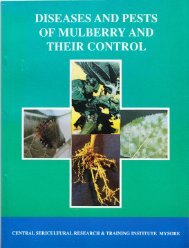

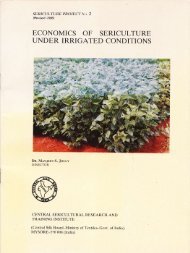
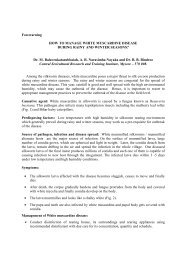
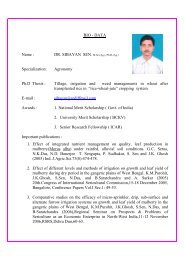
![E}A]\GALORE](https://img.yumpu.com/54052619/1/190x260/eagalore.jpg?quality=85)
